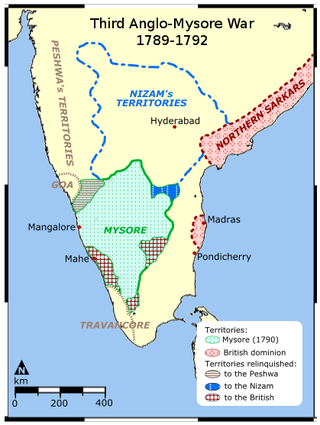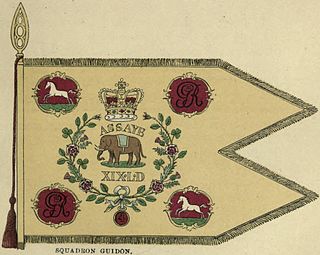
Hyder Ali was the Sultan and de facto ruler of the Kingdom of Mysore in southern India. Born as Hyder Ali, he distinguished himself as a soldier, eventually drawing the attention of Mysore's rulers. Rising to the post of Dalavayi (commander-in-chief) to Krishnaraja Wodeyar II, he came to dominate the titular monarch and the Mysore government. He became the de facto ruler of Mysore as Sarvadhikari by 1761. During intermittent conflicts against the East India Company during the First and Second Anglo–Mysore Wars, Hyder Ali was the military leader.

The Second Anglo-Mysore War was a conflict between the Kingdom of Mysore and the British East India Company from 1780 to 1784. At the time, Mysore was a key French ally in India, and the conflict between Britain against the French and Dutch in the American Revolutionary War influenced Anglo-Mysorean hostilities in India. The great majority of soldiers on the company side were raised, trained, paid and commanded by the company, not the British government. However, the company's operations were also bolstered by Crown troops sent from Great Britain, and by troops from Hanover, which was also ruled by Great Britain's King George III.

The First Anglo-Mysore War (1767–1769) was a conflict in India between the Sultanate of Mysore and the East India Company. The war was instigated in part by the machinations of Asaf Jah II, the Nizam of Hyderabad, who sought to divert the company's resources from attempts to gain control over the Northern Circars.

The Third Anglo-Mysore War (1790–1792) was a conflict in South India between the Kingdom of Mysore and the British East India Company, the Kingdom of Travancore, the Maratha Confederacy, and the Nizam of Hyderabad. It was the third of four Anglo-Mysore Wars.

The Great Siege of Gibraltar was an unsuccessful attempt by Spain and France to capture Gibraltar from the British during the American Revolutionary War. It was the largest battle in the war by number of combatants.

Ambur is a town and municipality in newly announced Tirupathur district, Vellore region of Tamil Nadu, India. It is located on the banks of the Palar River between Chennai and Bangalore. Ambur has a sizeable leather industry, and is known for its spicy biryani and for the sweet, makkhenpeda. Ambur was the site of two major military actions in the 18th century. The first was the 1749 Battle of Ambur that opened the Second Carnatic War between the Arcot State and the Mughal Empire. In 1767, the siege of Ambur took place during the First Anglo-Mysore War, with local troops and a British force successfully resisting an attack by the Kingdom of Mysore and by the Hyderabad State.

Vellore Fort is a large 16th-century fort situated in heart of the Vellore city, in the state of Tamil Nadu, India built by the Emperors of Vijayanagara. The fort was at one time the imperial capital of the Aravidu Dynasty of the Vijayanagara Empire. The fort is known for its grand ramparts, wide moat and robust masonry.

In the Blockade of Almeida a French garrison under Antoine François Brenier de Montmorand was surrounded by approximately 13,000 Anglo-Allied soldiers led by Generals Sir Alexander Campbell, 1st Baronet and Sir William Erskine, 2nd Baronet.

The military history of the United Kingdom covers the period from the creation of the united Kingdom of Great Britain, with the political union of England and Scotland in 1707, to the present day.

The 19th Light Dragoons was a cavalry regiment of the British Army created in 1781 for service in British India. The regiment served in India until 1806, and in North America during the War of 1812, and was disbanded in Britain in 1821.
The siege of Darwar was a twenty-nine-week siege of the fort at Dharwad in 1790 and 1791, then near the frontier, between the Kingdom of Mysore and the Maratha Empire. The Marathas, assisted by forces of the British East India Company, began the siege on 18 September 1790 and resulted with the surrender of Mysore garrison on 3 April 1791.
The siege of Coimbatore was a siege conducted by forces of the Kingdom of Mysore against a garrison of British East India Company and Travancore troops holding the fortress at Coimbatore in southern India during the Third Anglo-Mysore War. The siege began in May 1791, and several men trying to storm the fort were repulsed on 11 June, after which the garrison of Lieutenant John Chalmers was reinforced, and a larger Mysorean force was brought against it. The garrison eventually surrendered on 2 November. Tipu Sultan broke the terms of the surrender, and held the garrison's commanding officers prisoner. John Chalmers was also held prisoner by Tipu Sultan and his forces. It is believed that around 100 British soldiers were executed in captivity by the Mysorean forces.
The siege of Koppal was conducted during the Third Anglo-Mysore War by forces of the Nizam of Hyderabad under the command of Mahabat Jung, assisted by a contingent of British East India Company forces. The siege was poorly conducted, and the garrison surrendered principally because Bangalore had fallen in February 1791. The Siege of Koppal was conducted during the Third Anglo-Mysore War by forces of the Nizam of Hyderabad under the command of Mahabat Jung, assisted by a contingent of British East India Company forces. The siege was poorly conducted, and the garrison surrendered principally because Bangalore had fallen in February 1791.
The siege of Mangalore was conducted during the Second Anglo-Mysore War by Tipu Sultan and forces of the Kingdom of Mysore against a British East India Company garrison led by Colonel Campbell. The port city of Mangalore on the west coast of India was besieged from 20 May 1783 until the garrison capitulated on 30 January 1784 after being reduced to starvation; of the original garrison of 700 British soldiers and 2000 Indian troops there were only 850 survivors. The siege was one of the last major actions of the war; Mangalore was where the treaty ending the war was signed in March 1784.
The Siege of Tellicherry was a military embargo that happened in Thalassery. The Commander in Chief of the Mysore Calicut Province, Sirdar Ali, took siege of the British Military Barrack of Thalassery for 18 months. They British and the local administrators were blockaded within Thalassery by land as well as by sea. It was during the Second Anglo-Mysore War. The siege continued until reinforcements from Bombay under the command of Major Abington attacked the Mysore army and defeated them. Major Abington then moved south, capturing Calicut. The Siege of Tellicherry led to the fall of strongholds of the First Mysore conquest, led by Hyder Ali. Even though laterTipu Sultan came from Mysore to reinstate the conquered area to previous status.

The Vellore mutiny, or Vellore Revolution, occurred on 10 July 1806 and was the first instance of a large-scale and violent mutiny by Indian sepoys against the East India Company, predating the Indian Rebellion of 1857 by half a century. The revolt, which took place in the Indian city of Vellore, lasted one full day, during which mutineers seized the Vellore Fort and killed or wounded 200 British troops. The mutiny was subdued by cavalry and artillery from Arcot. Total deaths amongst the mutineers were approximately 350; with summary executions of about 100 during the suppression of the outbreak, followed by the formal court-martial of smaller numbers.

The fort was the East India Company's first permanent post on the Malabar Coast. In November 1693, John Brabourne was sent by the British East India Company (EIC) to Attingal, where he obtained from Rani Ashure a grant of a site for a fort on the sandy spit of Anchuthengu, together with the monopoly of the pepper trade of Attingal. The EIC commenced construction in January 1696.

Garrison Cemetery is located in Seringapatam, on the banks of the river Cauvery, about 300m from the Bangalore Mysore Highway. It has about 307 graves of the European officers killed in the final assault on Tippu Sultan in 1799, and their family members. Among the graves, there are 80 graves of the officers of the Swiss ‘de Meuron Regiment’, and the rest of the graves are their family members.

Għargħar Battery, also known as Ta' Ittuila Battery and Ta' Xindi Battery, was an artillery battery in present-day San Ġwann, Malta, built by Maltese insurgents during the French blockade of 1798–1800. It was part of a chain of batteries, redoubts and entrenchments encircling the French positions in Marsamxett Harbour and the Grand Harbour.

The siege of Pondicherry was a colonial military operation in the early stages of the French Revolutionary Wars. Britain and France both controlled colonies on the Indian Subcontinent and when the French National Convention declared war on Britain on 1 February 1793, both sides were prepared for conflict in India. British India was centred on the principal ports of Bombay, Madras and Calcutta, administered by the East India Company. French India was governed from Pondicherry on the Coromandel Coast. British forces in India were considerably stronger than the French, with the British Indian Army supported by British Army detachments and a Royal Navy squadron under Rear-Admiral William Cornwallis. Pondicherry's defenses were strong, but the garrison was too small to effectively man the walls, and although a French frigate squadron was stationed at the distant Île de France, it was unable to effectively protect the French Indian coast.














